Original Author: Karen, Foresight News
Recently, Starknet released a new roadmap, which confirmed plans to support the use of STRK to pay transaction fees in the V3 transaction structure, implying the imminent launch of the STRK token.
What are the five major items confirmed in the new Starknet roadmap? What stage has the Starknet token process progressed to? Which DeFi protocols are worth focusing on?
Starknet's major updates in the new roadmap confirm five main items
According to the latest roadmap released by Starknet, Starknet has confirmed 5 major items, namely network stability improvements, V3 transactions, transaction fee market, reducing L1 fees using EIP-4844, and reducing transaction costs through the Volition mode.
In terms of network stability improvements, Starknet released the "quantum leap" v0.12.0 version in July this year, focusing on improving network throughput and making significant improvements to the sequencer. Subsequently, Starknet released v0.12.1 (optimized transaction efficiency) and v0.12.2 (enabled P2P identity verification and increased maximum throughput and TPS) on the mainnet, and v0.12.3 (removed support for the Starknet feeder gateway) was released on the testnet this month.
In the V3 transaction structure being built by Starknet, it will support paying transaction fees with STRK. The V3 transaction structure will also support the following features (not all available in Starknet V0.13.0):
Fee Market: A fee market starting from Starknet v0.14.0 that allows users to optimize their transaction flow during congestion.
Paymaster mechanism: Similar to EIP-4337, it allows entities other than the transaction sender to pay transaction fees through fee abstraction.
Volition mode: Used to reduce data availability costs, introducing hybris state design, allowing users to choose their preferred data availability mode.
Nonce Generalization: Allows users to simultaneously send multiple transactions by specifying different channels for different transactions.
Account deployment will be done in the initial call or declaration transaction of the account.
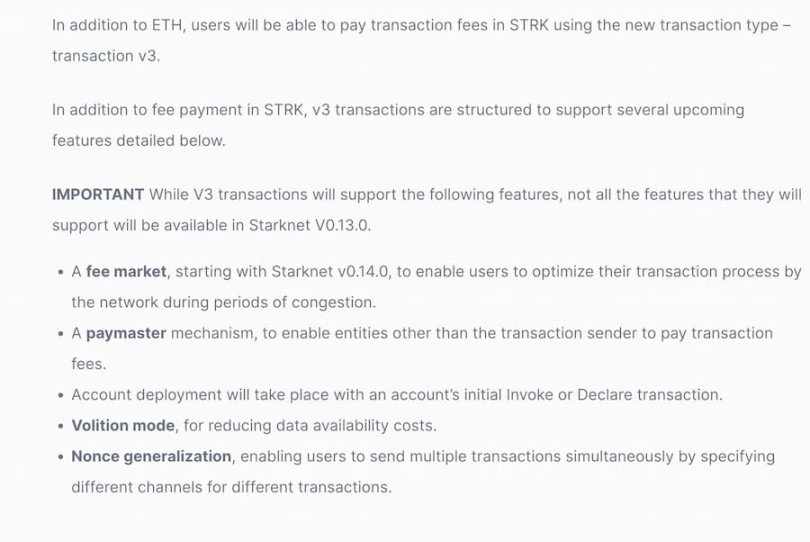
According to the SNIP 10 proposal for the STRK fee token, one of the main purposes of STRK is to serve as a fee payment token on Starknet. However, the original transaction version will continue to use ETH as the fee token. The Starknet sequencer will use off-chain STRK > ETH price feeds provided by Pragma Oracle. Starknet explains that this is only a temporary solution for centralized situations, and a long-term decentralized protocol proposal will be released later.
In addition, Starknet also plans to use EIP-4844 to reduce L1 fees. EIP-4844 reduces transaction fees by introducing a blob to carry transactions.
Some planned dates for Starknet network upgrades are as follows:
December 11, 2023: V0.12.3 mainnet launch.
December 5, 2023: V0.13.0 Goerli testnet launch. This date may be postponed by a week to December 13, if necessary.
January 22, 2024: V0.13.0 mainnet, pending governance vote.
Starknet token allocation model and progress
In November 2022, Starknet deployed the STRK token on the Ethereum mainnet, with the contract address: 0xCa14007Eff0dB1f8135f4C25B34De49AB0d42766. STRK will be used as a staking token for participating in the Starknet consensus mechanism, a governance token, and for paying transaction fees.
Regarding transaction fees, Starknet previously stated that fees are expected to be paid using native STRK tokens only. The plan to use both STRK and ETH as transaction fees simultaneously may only be transitional.
Discussions on the decision to use both STRK and ETH as transaction fees on the sequencer have sparked intense debate in the Starknet forum, as it may bring potential risks.
Staking STRK may also be used to ensure the network's activity and security, including services such as sequencing, achieving temporary L2 consensus before reaching L1 finality, STARK proof services, and data availability supply.
Starknet disclosed the token economics in mid-2022, with a maximum total supply of 10 billion STRK tokens, of which:
17% is allocated to StarkWare investors;
32.9% is allocated to core contributors, including StarkWare and its employees and advisors, as well as Starknet software development partners;
50.1% is granted by StarkWare to the foundation for distribution, including:
9% for community provisions, applicable to individuals working for Starknet and providing support or development for its underlying technology;
9% for community rebates (used to partially pay the fees for transitioning from Ethereum to Starknet); 12% for funding research and work on developing, testing, deploying, and maintaining the Starknet protocol;
10% for strategic reserves to fund ecosystem activities consistent with the foundation's mission;
2% to be decided by Starknet token holders and the foundation, donated to esteemed institutions and organizations, such as universities, non-governmental organizations, etc.;
8.1% remains undistributed, to be further allocated in a manner decided by the community to support the Starknet community.
All tokens allocated to core contributors and investors will be subject to a 4-year lock-up period (fully locked for one year, then released linearly).
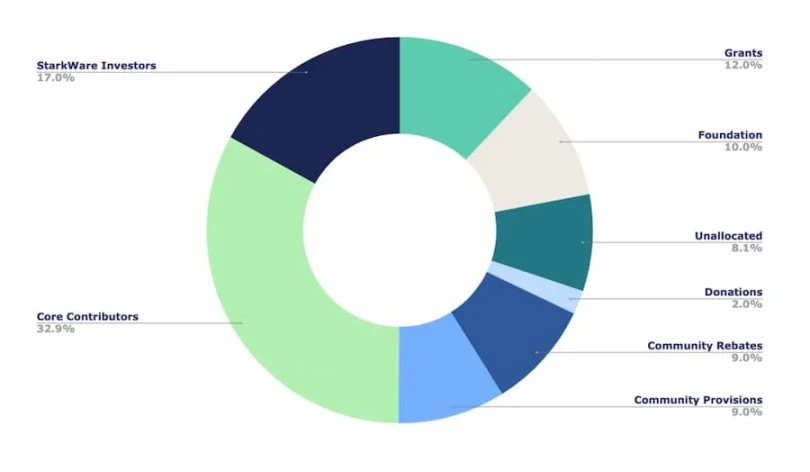
Starknet's decentralization and token allocation progress has been accelerating this year. In March 2023, the Starknet Foundation announced the appointment of five committees, including:
The Provisions Committee, responsible for planning, supervising, and executing the supply of the Starknet ecosystem's token STRK;
The Early Adopters Allocation Committee, dedicated to promoting the development of the Starknet ecosystem by providing funding to innovative teams building on Starknet;
The Developer Collaboration Committee, which will introduce new strategic developer partnerships by nurturing and overseeing them within the Starknet ecosystem;
The Governance Committee, tasked with playing a key role in the ongoing decentralization of the Starknet ecosystem;
The Ecosystem Access Committee, responsible for authorizing new developers and community members and integrating them into the Starknet ecosystem.
In May, the Starknet Foundation announced the first round of 67 projects to receive grants from the Starknet Early Adopter Grants (EAG) program. The total budget is 10 million STRK tokens, accounting for 0.1% of the initial STARK token issuance (10 billion tokens), and will be distributed to the projects in multiple rounds.
Among the projects that received grants, those launched on the mainnet before April 5th can unlock 100% of the grant tokens, while projects on the testnet can immediately unlock 25%, with the remaining 75% distributed within 2 months of the mainnet launch. Currently, there are 429 STARK holder addresses, most of which may be token recipients.
In October, the Starknet Foundation also launched the Starknet Early Community Member Program (ECMP), aiming to recognize community contributors who have contributed to Starknet so far. The program plans to distribute 50 million STRK tokens to individuals who contributed to the network in its early stages, including those who contributed to technical discussions, organized Starknet-related events, and regularly published Starknet brand content. The application window for this program has ended, and the committee will make a decision on December 29, 2023.
Which DeFi protocols are worth focusing on?
According to L2BEAT data, the current total value locked (TVL) on Starknet is $169 million, including all assets bridged to Starknet but not yet utilized. However, according to DefiLlama data, the TVL of DeFi on Starknet is only $35 million.
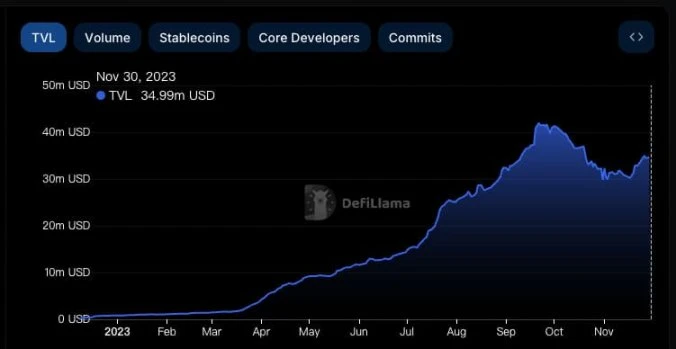
Source: DefiLlama
Although the TVL on Starknet's Layer 2 is not impressive and has been stagnant since August this year, its ecosystem is steadily expanding. The following image is the ecosystem landscape released by Starknet in late this month.
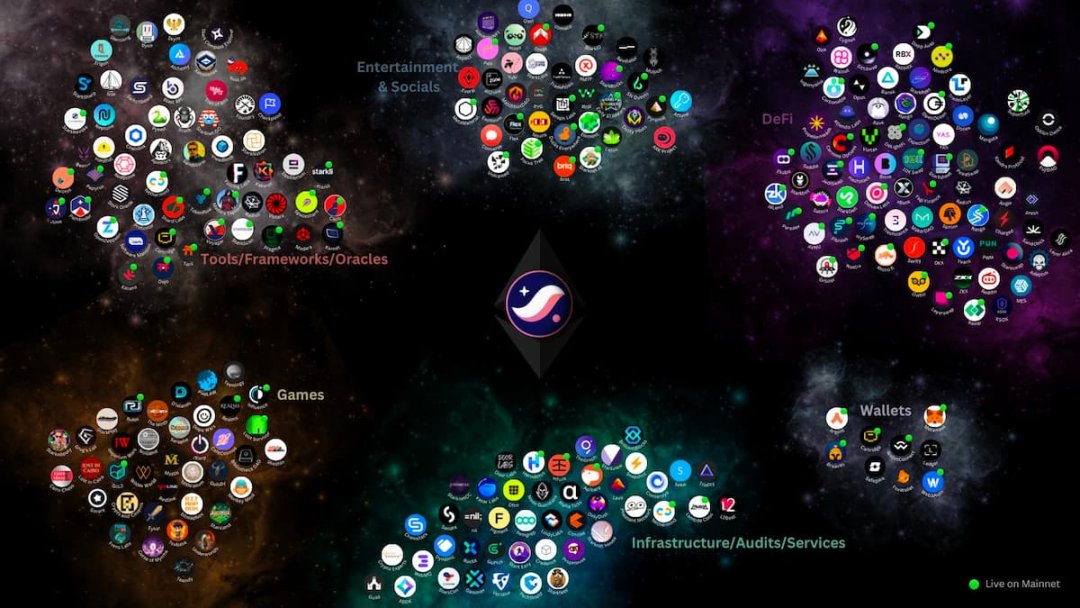
To guide and promote the development of the DeFi ecosystem on Starknet, the Starknet Foundation also announced the establishment of the DeFi Committee in November, with a budget of 50 million STRK. The committee's task is to research, design, and execute on-chain liquidity.
The DeFi Committee is chaired by six members, including Starknet Foundation administrator Damian, Argent co-founder and CEO Itamar Lesuisse, zkLend co-founder Jane Ma, AVNU co-founder and CEO Mentor, Nostra product lead Richard Thomas-Pryce, and ZKX CTO Vitaly Yakovlev.
I have selected 8 DeFi protocols worth focusing on and provided a brief introduction.
JediSwap
JediSwap is a permissionless and composable AMM protocol on Starknet, built by the Mesh Finance community. JediSwap was launched on the Starknet mainnet in December 2022, with a current TVL of approximately $10 million, ranking first on the Starknet network.
JediSwap received a grant of 150,000 STARK tokens in May this year, and prior to that, in January 2022, JediSwap also received a grant from StarkWare.
In JediSwap, liquidity providers can earn a 0.3% fee, proportional to their share in the pool. The fees are accumulated in real-time in the pool and can be claimed by withdrawing liquidity. JediSwap has also recently launched ZAP functionality, allowing users to swap any single token to any JediSwap LP position with just one Starknet transaction. According to JediSwap's roadmap released in the second quarter, an index product will be launched in the first quarter of next year.
Ekubo
Ekubo is an AMM protocol in the Starknet ecosystem built by Moody Salem, a former Uniswap team engineer supervisor and advisor. Ekubo uses concentrated liquidity and "till" mode, where all pools are managed in a single contract, and token transfers are delayed until the end of the transaction when users exchange or update positions on Ekubo. Aggregators can keep them in Ekubo for later use, completely avoiding expensive token transfers.
In addition, Ekubo also supports customizing pool behavior through writing extension contracts, allowing third-party developers to utilize the Ekubo AMM protocol to build oracles, new order types, trading strategies, and even privacy solutions.
According to Moody Salem, who joined Uniswap Labs as the fifth employee in April 2020, he wrote most of the early Uniswap interface, created token lists, wrote the first exchange routing algorithm for V2 and V3, submitted about half of the V3 code, and ultimately led the design of V4.
In October this year, Ekubo proposed a partnership with the Uniswap DAO to exchange 20% of future Ekubo protocol governance tokens for a contribution of 3 million UNI (approximately $12 million). The Uniswap community voted to approve the "Investment in EkuboProtocol" temperature check proposal, but Ekubo decided not to proceed with the proposal to invest in Ekubo by the Uniswap DAO and will not put the proposal to an on-chain vote. The reason is that implementing the proposed changes would impose a heavy burden on Ekubo and distract attention from the development of the Ekubo protocol.
mySwap
mySwap is an AMM protocol on Starknet that launched a new version last month, featuring concentrated liquidity (CL) configurations, allowing liquidity to be provided for specific price ranges to improve capital efficiency or for the entire price range. At the time of writing, mySwap's TVL is close to $7 million.
SithSwap
SithSwap is a dual-liquidity engine AMM that supports variable pools (similar to UNIV2) and stable pools (similar to Curve) trading. SithSwap is based on a dual-token incentive system, consisting of the native SITH token and xSITH (a transferable utility and governance token), both of which are provided as rewards.
SithSwap completed a $2.5 million seed round financing in June 2022 at a valuation of $25 million, with Lemniscap leading the round and participation from Big Brain Holdings, GSR Markets, DWeb3 Capital, Ghaf Capital Partners, and others.
SithSwap disclosed its token economics very early on, with a total supply of 100 million SITH tokens, including:
- 50.1% is allocated for reward distribution over the next 3 years;
- 10% is allocated to core contributors, with a linear release over 1.5 years;
- 6.8% is allocated to the treasury, with 2% allocated to partnerships and 4.8% allocated to the development fund;
- 10.6% is allocated to seed round investors;
- Of the 22.5% in the genesis portion, 15% is for public sale, 5% for initial liquidity, and 2.5% enters the genesis pool for linear distribution of xSITH over 6 months.
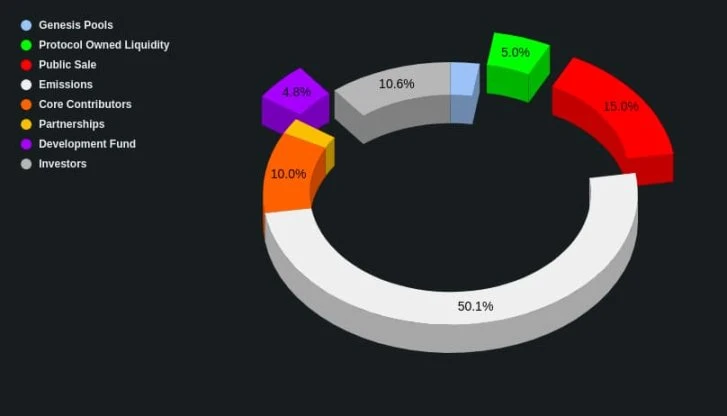
The following image shows the token release schedule modified by SithSwap 3 months ago, indicating the release of governance tokens this quarter.
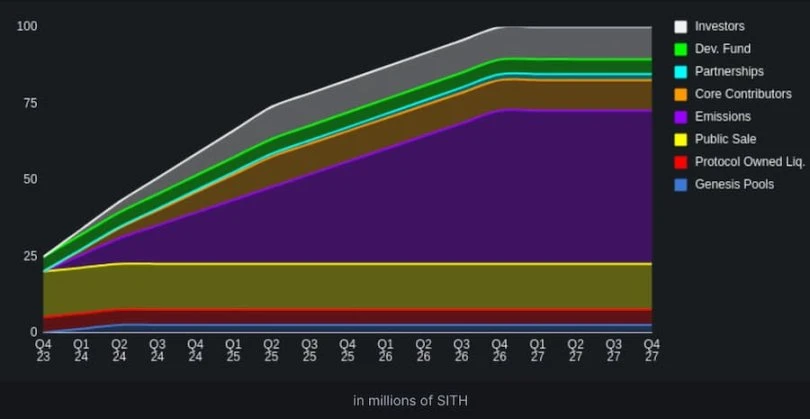
AVNU
AVNU has developed a Request for Quote (RFQ) system and a DEX aggregator on Starknet, aggregating liquidity from 10kSwap, JediSwap, mySwap, Ekubo, SithSwap, and others. In the RFQ system, AVNU's API integrates off-chain liquidity from professional market makers using the RFQ system, which is more suitable for large trades. For direct routing, AVNU charges a 0.02% fee; for complex routing, AVNU charges a 0.15% fee.
The leading smart contract wallet on Starknet, Argent, will integrate AVNU on its mobile wallet, allowing users to swap tokens across multiple trading platforms.
AVNU has also introduced a point system, allowing users to earn points through trading, with the number of points related to the number of trades, trade amounts, frequency, and more.
zkLend
zkLend is a native L2 money market protocol built on Starknet, which completed a $5 million seed round financing in March 2022, with Delphi Digital leading the round and other investors including StarkWare, Three Arrows Capital, Alameda Research, MetaCartel DAO, Amber Group, Genesis Block Ventures, and others.
zkLend officially launched on the Starknet mainnet in October 2022, with features including input multiplexing, support for more assets (including wstETH), and more. According to zkLend's roadmap, cross-chain lending and zkLend Institutional MVP will be enabled in the fourth quarter.
zkLend has also disclosed its token economics on its website, with a total supply of 100 million tokens, with 17% allocated to private and public investors, 15% to the team and advisors, 17% to the ecosystem, and 35% to staking and distribution rewards.
The zkLend whitepaper states that ZEND tokens can be staked to mint stZEND, and stZEND holders can share protocol revenue, increase release rewards, and gain governance rights.
Nostra
Nostra, developed by the team behind the yield tokenization and fixed-rate protocol Tempus Labs, serves as a liquidity layer on Starknet, supporting lending and trading services. Nostra will also launch UNO, a Starknet-native stablecoin pegged to the US dollar. Users can deposit ETH into Lending and convert it to iETH-c, which is used as collateral to mint UNO.
Last August, Tempus Labs allocated 5 million DAI to Nostra to support the development of the Nostra ecosystem.
Friendly reminder: Most native Starknet projects are in the early stages of development, and users should interact with caution. Before interacting with any protocol, investors should conduct thorough research and due diligence to understand the risks and potential rewards.
References:
https://www.starknet.io/en/roadmap
https://community.starknet.io/t/announcing-the-early-community-member-program/102092
https://github.com/starknet-io/SNIPs/blob/main/SNIPS/snip-8.md
https://github.com/ob1337/SNIPs/blob/snip-10/SNIPS/snip-10.md
免责声明:本文章仅代表作者个人观点,不代表本平台的立场和观点。本文章仅供信息分享,不构成对任何人的任何投资建议。用户与作者之间的任何争议,与本平台无关。如网页中刊载的文章或图片涉及侵权,请提供相关的权利证明和身份证明发送邮件到support@aicoin.com,本平台相关工作人员将会进行核查。




